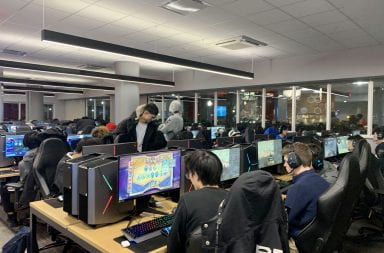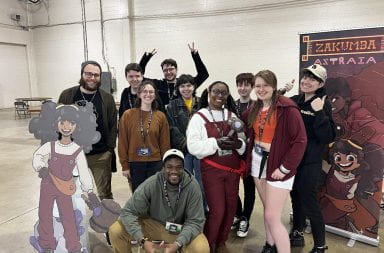From Tulsa, Oklahoma, to Columbus, two graduate students bring a college class that dives into a nontraditional form of art to Ohio State.
“Analyzing Video Games,” English 2367.01, is a second-year writing class originally created by Zachary Harvat and Drew Sweet, both graduate teaching associates studying English at OSU, where students analyze video games and how they impact culture. The enjoyment of playing video games helped inspire Sweet and Harvat, but they also saw creating this class as an opportunity to bring critical attention to games from a humanities perspective.
While attending the University of Tulsa, Harvat had the opportunity to take a course on video games, which he felt opened his eyes to that field of study. This course helped him shape the course at OSU, where he even created his own “game room” consisting of a couple Xbox 360s that students in the game-studies course can stop by and play for homework.
While this class looks into the entertaining topic of video games, Nathan Richards, a graduate teaching associate studying English who teaches a section of the class, said he still intends this course to help students continue to develop their writing and critical-thinking skills. The list of video games to be studied isn’t officially completed yet, but Richards plans to study a variety of genres and styles of games, including “Portal,” “Bioshock” and “The Elder Scrolls V: Skyrim.” As access to different models of gaming consoles is scarce, Richards plans on using Xbox 360s for the majority of the course.
Richards said he wants his students to have fun, as it is a central aspect to gaming, but he expects his students to take the games seriously and complete genuine intellectual work. He said the increased popularity of video games lends the medium to being academically studied and critiqued.
“While I am not as avid a gamer as I once was, video games have been central to my personal and intellectual development,” Richards said in an email. “I am invested in the medium and culture.”
Sweet also said students in the course analyze the choices made in game design and construct arguments about what specific mainstream and independent games do to convey narratives; imply beliefs about people, ideas and the world; represent groups or identity categories; and provide certain experiences of play.
“The ultimate goal is to provide a way for students to engage critically with video games,” Sweet said in an email. “Most of our students have much experience with playing video games, but they don’t necessarily have an outlet for considering what … games mean. We want to push people to consider what games do other than provide experiences for us to consume.”
The English 2367.01 courses being offered next autumn examine language, identity and culture in the U.S. experience. In addition to the Analyzing Video Games course, the Disability in Literature, Media and Culture course dives into topics about major concepts in disability studies. Students will also explore the work of writers, artists and filmmakers and how they represent the disabled in media.
Although video games use some of the same techniques as film, such as cutscenes, Harvat said he feels video games and film are two different forms of media. While he feels film is able to accomplish more when conveying messages, the interaction between the player and the game, where players are forced to face ethical dilemmas, is something quite different from the interaction between spectator and film.
“Video games are also a much (newer) medium, so we’re very much seeing the form in its adolescence right now,” Havart said an in email. “I think the future of games is really exciting.”


